.jpg)
Though nary a butcher, a baker, nor a candlestick maker to be found among them, skipper John Ensor, Peter Richards, and writer Austen Wilks, nevertheless decided to sail around Penang in a sturdy but small sailboat, setting out from Batu Uban, a boatyard under the lee of the First Penang Bridge.
Of course Penang’s always had a maritime past, though the early explorers, such as James Lancaster, who came to what is now Batu Ferringhi in the early seventeenth century, and Francis Light, who founded the colony of Penang in 1786, must have seen very different views of the island. Then it was dark green jungle right down to the water’s edge. Now the east coast has grown white harvest of irregular skyscraper teeth in a landscape transformed by the red tiles of earlier development, leaving very little green.
Sailing under the New Bridge Before setting sail the skipper did the chart work. He plots our pilotage around the jungles of Pulau Jerejak – still almost untamed – using a mixture of traditional paper and modern GPS-enabled electronics. White on the chart, the deep water has directed the position of the navigation channel under Penang’s newly opened second bridge.
The huge scale of the construction makes our progress towards it seem slower. The transit is even more impressive than passing through its preceding twin because the curve of the roadway lends a scaling perspective to the human eye. We chat about bridges we have known, and I speak of the illusion that our mast will not fit under it as the eye is tricked by the low angle of clearance whilst we approach from a distance. The bridge section, however, has been designed to let huge liners pass under safely. As we come closer, our little boat is dwarfed, and we pass easily under the massive structure.
Rounding the Southern Cape
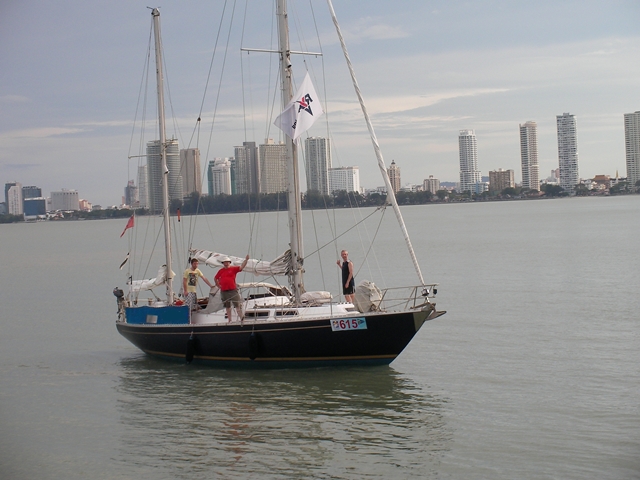
As soon as we are through, the southernmost point of our island is at hand. A tiny kampung is perched between sea and jungle, betrayed to the eye by its tin roofs, which have replaced traditional attap thatch within recent memory. There’s good fishing for the people living here and we see men in huge hats working their nets in a boat whose shape remains unchanged from antiquity, although glass fi bre and the outboard engine have made their harsh life easier. A little further along the jungle creeps down to the water’s edge, only leaving bare the steepest rocks to be washed by the tide.
At the southernmost point we see a broad channel between us and the islet of Rimau, but we must pick our way through the bobbing markers of the fishermen’s nets, red pennants and blue, fluttering gaily, conforming to no standard navigation system. I take the opportunity to advise my seasoned and gnarled companions that in these waters the owners of the nets usually keep watch, and we shall likely be visited by a speeding native craft, with oversized engine, if we approach too close. But our caution pays off, and within a few minutes we are passing the buildings of Kampung Sungei Ara near the end of the runway of the international airport at Bayan Lepas.
The Wild West Coast
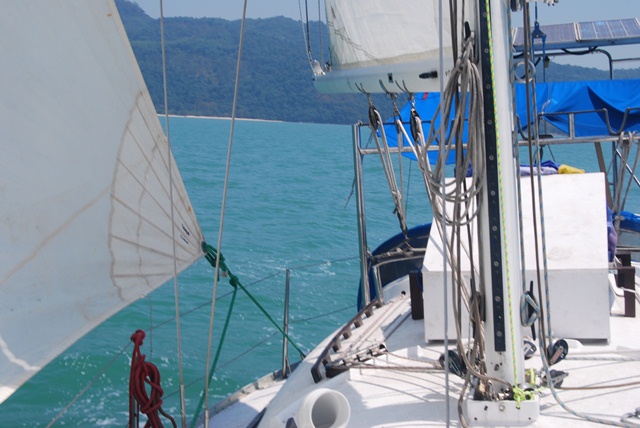
At once the shore is wilder and detail is lost as we veer to the south far enough out to sea to double the cape at the southwest corner – Pasir Panjang. After this, we can change course to the north and pass along the west coast – apparently almost deserted – fringed with mangroves impeding any attempt to land except at the rare isolated fishing kampungs, such as Betong.
This untenanted coast shimmers in the sweltering sun of early to mid-afternoon and as we pass beside the National Park we come eventually at tea time to the north-western corner where Muka Head light shines out at night to warn shipping. By day this lighthouse is almost completely hidden by the jungle at the top of the hill. For most of the day the winds have been light, but at evening the forecast of a stronger breeze from the North West is realised and becomes favourable as we round Muka. Distant skyscrapers appear at the horizon’s edge, their feet hidden beyond the curve of the world.
Back to Civilisation
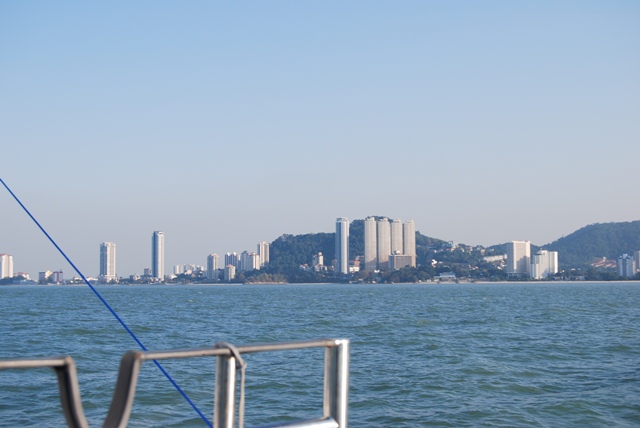
Closer at hand the high buildings of Batu Ferringhi loom, where Lancaster made landfall, perhaps leaving a trace from the naming of the place which means ‘Rock of the Foreigners’ in Malay.
My two companions set the spinnaker, a huge lightweight sail that billows out in front, and which the helmsman must keep from collapsing by skilful maintenance of the downwind course.
My mouth gets drier and drier as I feel the regular swells approaching our boat at an angle from behind. They push the stern to one side as they meet the vessel. I learn to lean the right amount on the tiller, apparently to under-correct this tendency to yaw and collapse the huge sail. The minimal correction is right, for as the wave passes under the stern, the boat swings back in the opposite direction, ideally directly back on course.
Man at the Helm
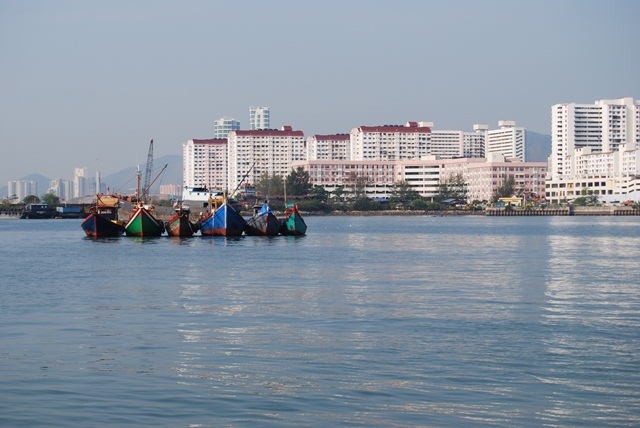
As I make mistakes the quiet voice of Peter, a seaman who has steered racers in the Southern Ocean, instructs me. Now he says: “Bear away”, and now: “Not too much”, and I comply, saving the day, avoiding a broach and the inevitable collapse of the sail in a cat’s cradle of ropes, perhaps with the accompaniment of all the bad language at a sailor’s command.
Riding on air, across the short slantwise swells that have developed in the widening straits, we race downhill on wings of wind towards the habited and familiar part of our island. At evening we speed under full sail past the headland of Tanjong Bungah. Pulau Tikus comes into view. It has a long, long tail from this angle and at this low point of tide. Creaming past we turn inwards towards an anchorage often used in this part of the monsoon. Before the fall of night we are snugged up under the island. We can observe and recognise the well-known lights of the shore, but we are anonymous to them, revealing only our anchor light. We eat and we sleep somewhat uneasily on the northwesterly swells.
Before dawn, I am awoken by the glints of the torch and the rattle of the keyboard as the electronic anchor warning is unset, and we breakfast as the sun gains power over Sebarang Prai.
Manhattan on the Indian Ocean
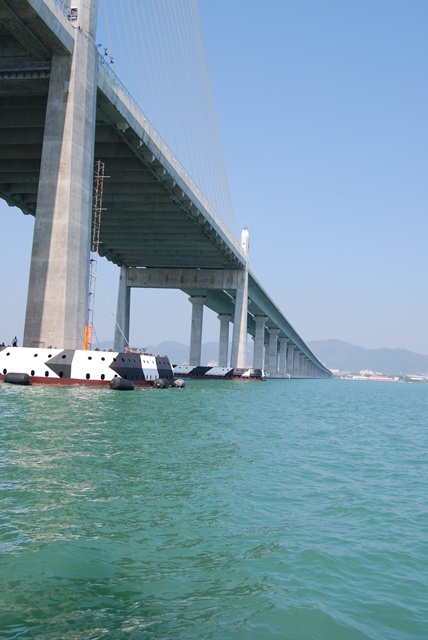
Skyscrapers become thicker as George Town gets closer. It is Manhattan on the Indian Ocean. Improbably a square-rigged barque is berthed alongside at Weld Quay, next to the modern cruise ships catering for sportsmen of the night. The barque gives a ghostly hint of what the place might have looked like in the age of sail when battleships of the Royal Navy’s East Indies fleet first dominated these waters.
We carefully avoid the ferries to the mainland that still ply their trade despite the competition of the fi rst road bridge. Will they survive after the opening of second, now imminent?
Round the easternmost point there is the traditional junk anchorage, off the clan jetties that still poke out into the deeper water here. We nose our way in to identify the yachts and then move out way back to the lowlands of Gelugor, passing through the navigation channel of the first bridge and home to our marina berth, behind which lie all the comforts of civilisation.
Before we berth and go back to shore life, I just have time to refl ect how different this island looks from the sea. This voyage, although short, has been very rich in experience. In a way it’s been a kind of time travel – we’ve seen glimpses of Penang’s past as well as her present and possible future.
Source: Penang International April/May 2014
Read more:
- Exploring the Hilly Slopes of Penang’s Famous Hill
- Chasing the Creatures of the Kinabatangan
- Photo Essay: The Penang of the Past
What are your thoughts on this article? Let us know by commenting below.No registration needed.
"ExpatGo welcomes and encourages comments, input, and divergent opinions. However, we kindly request that you use suitable language in your comments, and refrain from any sort of personal attack, hate speech, or disparaging rhetoric. Comments not in line with this are subject to removal from the site. "




















